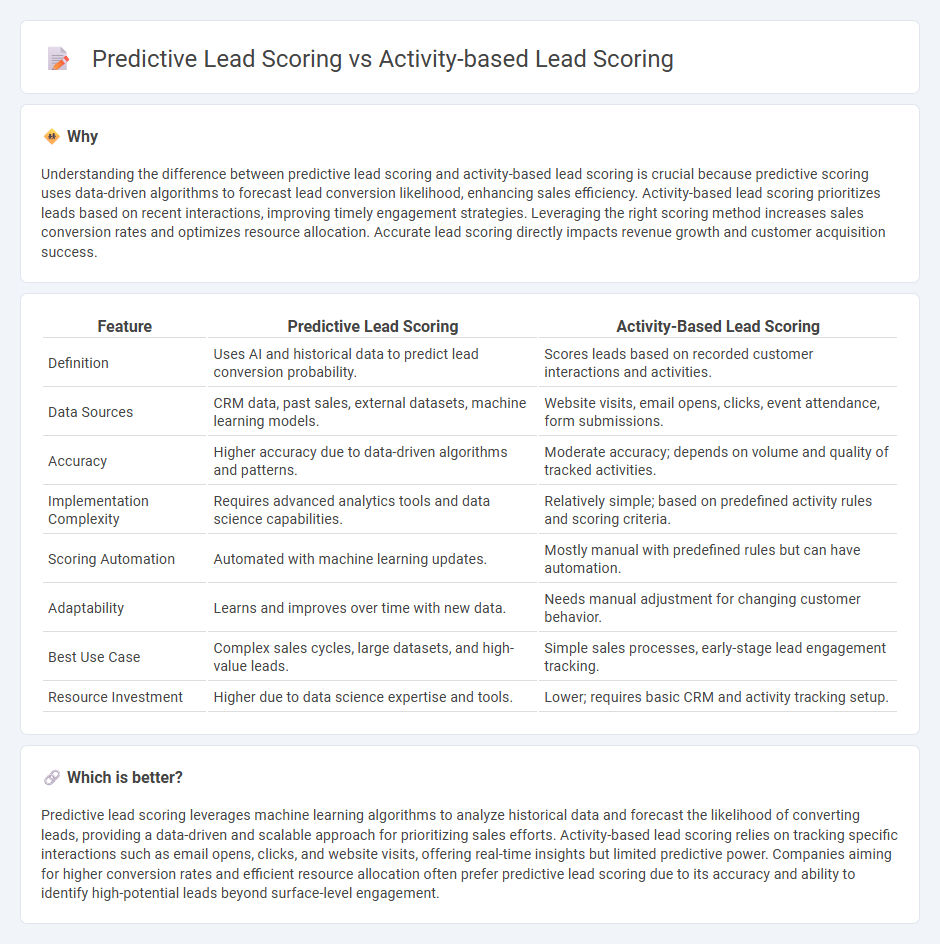
Predictive lead scoring utilizes machine learning algorithms to analyze historical data and forecast the likelihood of leads converting, while activity-based lead scoring prioritizes prospects based on recent engagement actions like email opens or website visits. Predictive models offer a data-driven, dynamic approach that adapts to evolving buyer behaviors, whereas activity-based scoring relies on predefined user interactions that may not always correlate directly with conversion potential. Explore in-depth strategies to maximize your sales pipeline efficiency with predictive and activity-based lead scoring methods.
Why it is important
Understanding the difference between predictive lead scoring and activity-based lead scoring is crucial because predictive scoring uses data-driven algorithms to forecast lead conversion likelihood, enhancing sales efficiency. Activity-based lead scoring prioritizes leads based on recent interactions, improving timely engagement strategies. Leveraging the right scoring method increases sales conversion rates and optimizes resource allocation. Accurate lead scoring directly impacts revenue growth and customer acquisition success.
Comparison Table
| Feature | Predictive Lead Scoring | Activity-Based Lead Scoring |
|---|---|---|
| Definition | Uses AI and historical data to predict lead conversion probability. | Scores leads based on recorded customer interactions and activities. |
| Data Sources | CRM data, past sales, external datasets, machine learning models. | Website visits, email opens, clicks, event attendance, form submissions. |
| Accuracy | Higher accuracy due to data-driven algorithms and patterns. | Moderate accuracy; depends on volume and quality of tracked activities. |
| Implementation Complexity | Requires advanced analytics tools and data science capabilities. | Relatively simple; based on predefined activity rules and scoring criteria. |
| Scoring Automation | Automated with machine learning updates. | Mostly manual with predefined rules but can have automation. |
| Adaptability | Learns and improves over time with new data. | Needs manual adjustment for changing customer behavior. |
| Best Use Case | Complex sales cycles, large datasets, and high-value leads. | Simple sales processes, early-stage lead engagement tracking. |
| Resource Investment | Higher due to data science expertise and tools. | Lower; requires basic CRM and activity tracking setup. |
Which is better?
Predictive lead scoring leverages machine learning algorithms to analyze historical data and forecast the likelihood of converting leads, providing a data-driven and scalable approach for prioritizing sales efforts. Activity-based lead scoring relies on tracking specific interactions such as email opens, clicks, and website visits, offering real-time insights but limited predictive power. Companies aiming for higher conversion rates and efficient resource allocation often prefer predictive lead scoring due to its accuracy and ability to identify high-potential leads beyond surface-level engagement.
Connection
Predictive lead scoring and activity-based lead scoring both enhance sales efficiency by identifying high-potential prospects through data-driven insights. Predictive lead scoring uses machine learning algorithms to analyze historical customer data and forecast lead conversion probability, while activity-based lead scoring evaluates real-time interactions such as email opens, website visits, and demo requests to prioritize leads showing immediate interest. Integrating these methods enables sales teams to focus efforts on leads with the highest likelihood of closing, optimizing resource allocation and boosting revenue generation.
Key Terms
Engagement Metrics vs. Machine Learning
Activity-based lead scoring prioritizes engagement metrics such as website visits, email opens, and content downloads to qualify leads based on their demonstrated interactions. Predictive lead scoring leverages machine learning algorithms to analyze historical data, identifying patterns and predicting leads' likelihood to convert with higher accuracy. Discover how combining these approaches can enhance your lead qualification strategy.
Manual Criteria vs. Data-driven Insights
Activity-based lead scoring relies on manually defined criteria such as website visits, email opens, and event attendance to evaluate lead quality. Predictive lead scoring uses machine learning algorithms and historical data to identify patterns and forecast lead conversion potential more accurately. Explore the differences in depth to optimize your lead qualification strategy.
Historical Activities vs. Predictive Analytics
Activity-based lead scoring evaluates prospects based on their historical interactions, such as website visits, email opens, and event participation, providing a straightforward measure of engagement. Predictive lead scoring uses machine learning algorithms to analyze a wide range of data points, including demographics, firmographics, and past behaviors, to forecast a lead's likelihood to convert. Explore more about how combining these approaches can optimize lead qualification and sales strategies.
Source and External Links
Activity-Based Lead Scoring Explained - Customers.ai - Activity-based lead scoring assigns values to different customer behaviors to prioritize leads most likely to convert, using technology to track activities like website visits or webinar attendance, and requires ongoing refinement based on conversion effectiveness.
The Ultimate Lead Scoring Guide for Salesforce and Braze - This method tracks digital interactions throughout the buying cycle, scoring leads higher when engaging with buying signals such as pricing pages or demo requests, and lower for irrelevant behaviors like visiting a career page.
What is Activity in Lead Scoring? - Breadcrumbs.io - Activity scoring evaluates behavioral data for high-intent buying signals, combined with fit metrics to deliver a co-dynamic alphanumerical score that helps sales assess lead readiness based on individual user actions.
 dowidth.com
dowidth.com